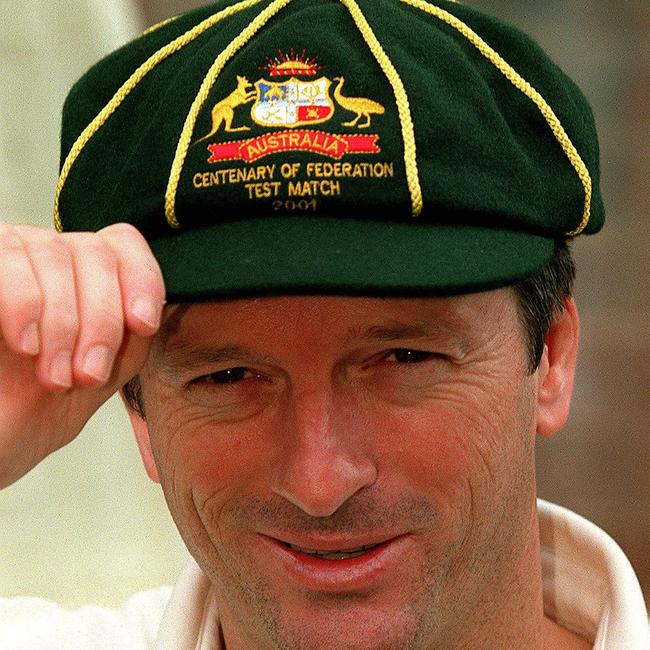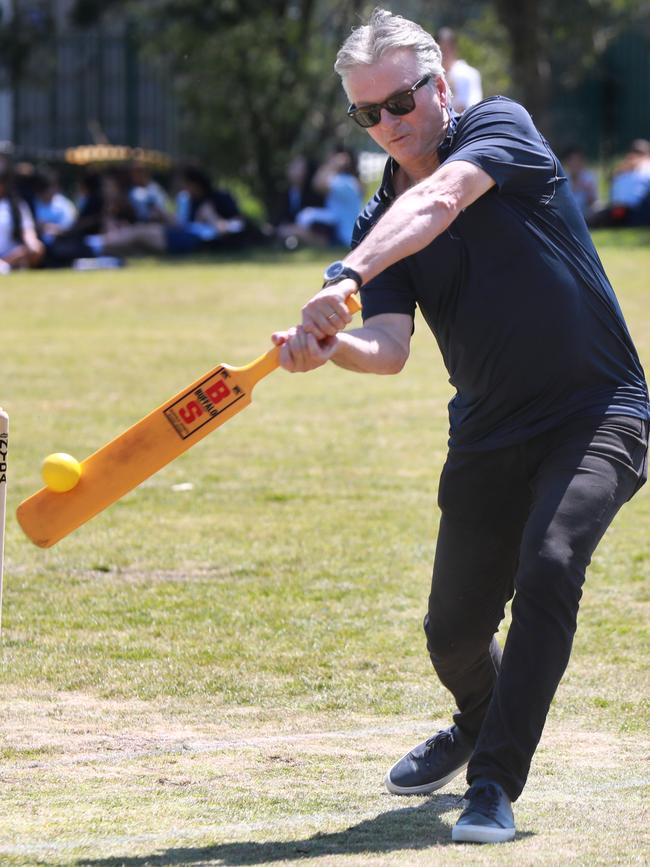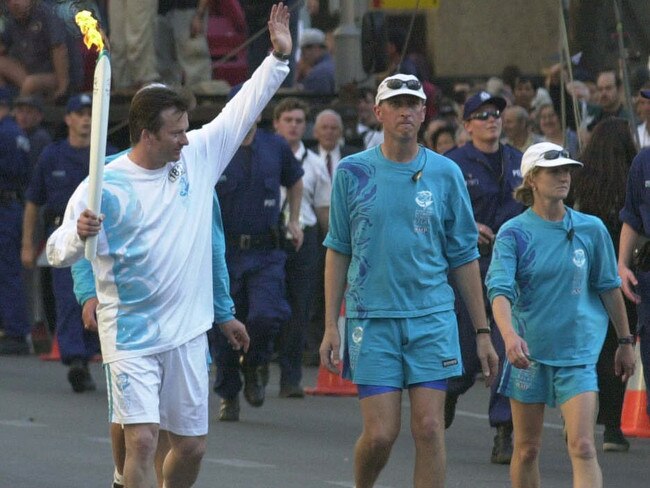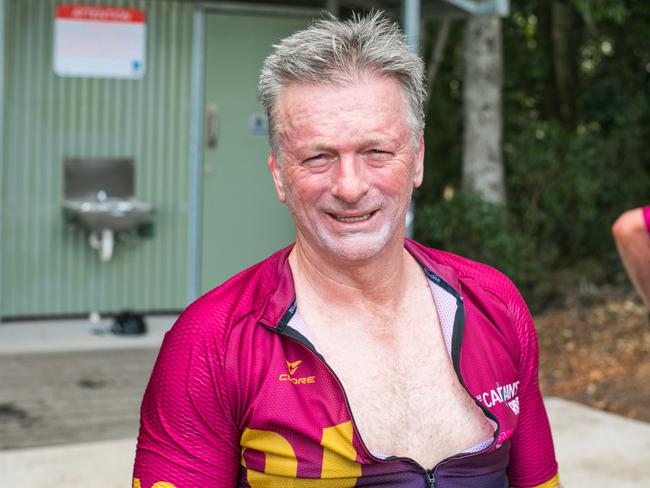For Cap And Country: Aussie cricketers share their love for the sport and life on the field
Australian cricketer Steve Waugh has wound back through the eras and shared his experience on the field, while sporting the Centenary of Federation commemorative baggy green cap.
National
Don't miss out on the headlines from National. Followed categories will be added to My News.
In what began as a passion project, Jesse Hogan, Simon Auteri and Andrew Faulkner began interviewing Australian cricketers about what it means to put on the baggy green cap.
‘We’re together and united and up for the battle’
The formerly green twine in Steve Waugh’s cap winds back through the eras.
It goes back through the time of Benaud, then weaves past Bradman to the Big Ship and Bannerman.
Connecting the first and second golden ages of Australian cricket was just as Waugh intended when he hoisted the baggy green to a new, exalted place either side of the millennium.
Ask Waugh to nominate his boyhood heroes and he says Bradman and Bill O’Reilly and Stan McCabe.
Now, Waugh’s getting on a bit, but he’s not that old. He wouldn’t have seen any of that famous trio play.

Yet the quintessential Australian cricketer was shaped by the far past.
Perhaps he had an innate sense that he was destined to join them.
He grafted his love for the game, and respect for its history, to his fellows – and his nation – through the cap.
The cap was the vehicle, the symbol, but to Waugh it was even more than that.
MORE NEWS
Aussies welcome back master motivator
‘Expendable leader’ fighting for Test relevance
Legend’s secret role steeling players for Waugh
“It was obviously a symbol and something to keep and cherish, but I don’t think it was held in the same regard as it is now,” Waugh said.
“It was obviously massive for me and something I’d aspired to. To get that bottle-green cap with its shiny crest … it felt great to wear it. And to make that very elite, senior club.
“I wanted to elevate it even further.”


Any story needs background – ‘never assume’ is a journalistic cornerstone – but in the case of Waugh and the baggy green, some prior knowledge is assumed.
Suffice to say, thanks to Waugh, the cap became more than a symbol.
And his own cap told the story quite literally: it devolved from bottle-green to the brown of his native land.
MORE NEWS
Steve Waugh won't save us as coach
‘Angry’ Paine’s hilarious DRS sledge
Aussies call on Waugh to end 18-year Ashes drought
It was scorched and faded by the sun and weathered by the other elements, mostly liquid elements: beer and champagne from the 1989 Ashes triumph; sweat from his even 200 at Kingston in 1995 to end the Windies’ long reign at the top of world cricket; and blood from a nose flattened by Jason Gillespie’s (broken) leg in Sri Lanka.


His cap is more deeply imbued with character than several cellars-full of Burgundy oak.
The sacred national relic now sits in a venerated corner of the SCG Museum.
A word beginning with ‘i’ and ending with ‘n’ is the most clichéd and overused label in Australian sport, and indeed Australian journalism, but in Waugh’s case it fits – his cap is a sacred religious representation, and the religion in question is cricket.
Like his cap, the man was shaped by his environment.
Waugh and his three brothers had three cricket ‘grounds’ at their home in western Sydney.
They’d choose a pitch and spin the bat – hills or valleys (flats or rooftops, rough or smooth, in other parts of the nation).
There were two tosses: one to decide who would bat or bowl, and the other to determine who was who.
“Whoever lost the toss would be the Poms,” Waugh said.
The front yard had a Lord’s-like slope.

“So that probably explains why both Mark and I were good off our pads,” he said.
The driveway at the side of the house ran downhill – hence the twins both evolving into brisk medium-pacers. (Steve, remember, repeatedly bounced Viv Richards at the Gabba in 1988.) Little wonder both twins laughed in the face of express bowling.
“It was hard work for the batsmen,” Waugh said with the droll dial set to maximum.
The third arena was a backyard that was ‘a bit of a minefield’.
Here he learned how to dig in when the going was tough. Lord’s, the WACA and a subcontinental turner – Waugh’s backyard cricket shaped the champion batsman, who took the baton from Allan Border and handed it to Ricky Ponting.
MORE NEWS
Dr Who meets James Bond in new season sneak peek
The best and worst gadgets we’re addicted to
What to do with unwanted Christmas gifts
But, as he said, today children are fortunate just to have a backyard, let alone three distinct playing areas.
“The backyards in Australia have really shrunk. When we were young, you could play sport wherever you wanted – in the backyard, at school, in the park, in the street,” he said.
“It’s definitely changed for a lot of reasons. Safety is one reason. As soon as we were up, we were outdoors and roaming all over the suburbs.
“The only rule was we had to be home before dark. These days, there doesn’t seem to be the same opportunities. At school, there was a big wall that you’d hit tennis balls against.
“You’d always be throwing a ball around, which would help your fielding skills. I think you lose a lot of skills if you’re not living that outdoor lifestyle that we had.”
Of course, not all Waugh’s role models were from the history books; he tried to bat like Viv and Dougie, and bowl like Lillee and Thomson.

Disappearing backyards and competition for young talent are problems to be addressed by the game’s guardians.
“I don’t think we’re going to fix up the backyard problem,” Waugh said.
But the issue of competing sports can be solved. Instead of talented young players being made to choose between sports at an early age, we should let kids be kids and experience the joy of multiple sports.
He argued that administrators should consider not excluding star youngsters from other sports.
“The way it is these days is they say: ‘We want you. You’ve got to train. You’ve got to be in these elite squads.’ So it’s up to the various codes to relax it a bit,” he said.
That Waugh lifted the baggy green to a new plane is in part a product of the modest circumstances in which he received his.
“I can’t remember who gave me my first cap. Or even if it was the cap I got given when I made the under-19 team,” he said.
When Mark Taylor succeeded Border, the new skipper introduced cap presentations.

Waugh took it to another level again when he brought in past players, such as Bill Brown and Ian Meckiff, to conduct the ceremonies.
Waugh is indelibly linked with the practice of the complete XI wearing their baggy greens in the first session of a Test, a tradition that actually started during Taylor’s captaincy after Waugh suggested it at a team meeting.
“I think as a team it gives you strength, all walking out together wearing your baggy green caps,” Waugh said.
“When we walked onto the field, we looked like 11 prize fighters.
“We’d be ready for the fight. We’re together and united and up for the battle.
“It looks like you’re going to be a hard team to break down in all different shades of green.”

The different shades he refers to range from the vivid green of the debutants’ caps to the scuffed and salt-stained hue of his own baggy green. What does he say to those who claimed he demeaned his station by wearing a tatty cap?
“It did [look tatty]. But that’s why I loved it. It had seen the good times and the bad times,” he said.
“There was blood from the collision with Jason Gillespie. It had been all around the world. It told the stories of all the amazing memories. Every imperfection had a story to tell.”

Waugh is to the baggy green as Marsh is to Lillee. Does he tire of being wedded to the cap?
“I’m happy with that. That’s a great thing to be associated with. People say it’s only a five-dollar piece of cloth. To me it’s a lot more than that. You only get one these days, which is great. It’s more in keeping with how special it is,” he said.
This is an extract from For Cap and Country: Interviews with Australian cricketers on the enduring spirit of the baggy green by Jesse Hogan, Simon Auteri and Andrew Faulkner. Published by HarperCollins and now available in all good bookstores and online.
Originally published as For Cap And Country: Aussie cricketers share their love for the sport and life on the field


